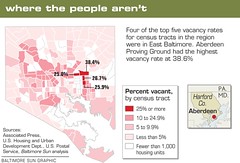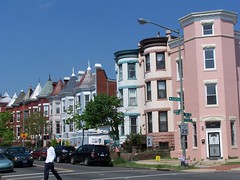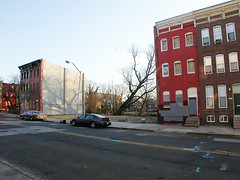Art for arts sake

Kudzu(Courtesy of Fred Scharmen). Fred Scharmen's image on the survey site was a wall of kudzu, an invasive and fast-growing vine: "It's cheap, easy and green," he said.
Sometimes I am not enthralled by the creative impulse. I guess it can come about when there are no other choices, but the best infill option for gaps between rowhouses is more houses, more residents in the neighborhood contributing their social, cultural, and economic value to the community.
In this case, I'd say, focus on what the real issue is, a local economy that is broken at the neighborhood level. Figure out why this is so and work to fix it. That is how you get vacant houses fixed up and occupied, and is what makes developing now empty lots economically viable. See "Tops in vacancies: Aberdeen Proving Ground is state's emptiest neighborhood," from the Baltimore Sun, which discusses the leakage of population from many Baltimore neighborhoods.

Baltimore Sun graphic.
Filling up gaps with art projects isn't a lot different than the NYC initiative in the 1970s to put decals with people in them on the windows of bombed out buildings in the South Bronx.

Rowhouses in DC's Bloomingdale neighborhood.
See "Web site sparks creative ideas for city's vacant lots" from the Baltimore Sun. From the article:
Most people looking at the Baltimore street scene see only the wasted, litter-strewn space between two rowhouses. But some see opportunities to hang a tightrope, build a skate ramp or plant a tree. Another imagines towering waterfalls in the summer -- and glaciers in the winter.
They have posted their sometimes outrageous ideas on a new Web site launched by the city to spark conversation about unused urban space. Called the Baltimore Infill Survey, the flickr page has caught the attention of artists, architects and other creative minds -- more than 50 of them -- who have definitive ideas of how to make the spots useful, productive, and especially, green.
Baltimore's Office of Promotion & the Arts put up the site, along with a template image of an empty lot. The suggestions so far largely involve buildings using sustainable materials, as well as parks and gardens. But they also include some less literal ideas, such as the waterfall or a fire pit.

The empty lot. Image from the Baltimore Infill Survey. Artists, architects and other creative minds have modified this test image of a Baltimore vacant lot with their ideas on how to use the space.
Labels: building a local economy, economic development, housing market, neighborhood planning, public art



0 Comments:
Post a Comment
<< Home